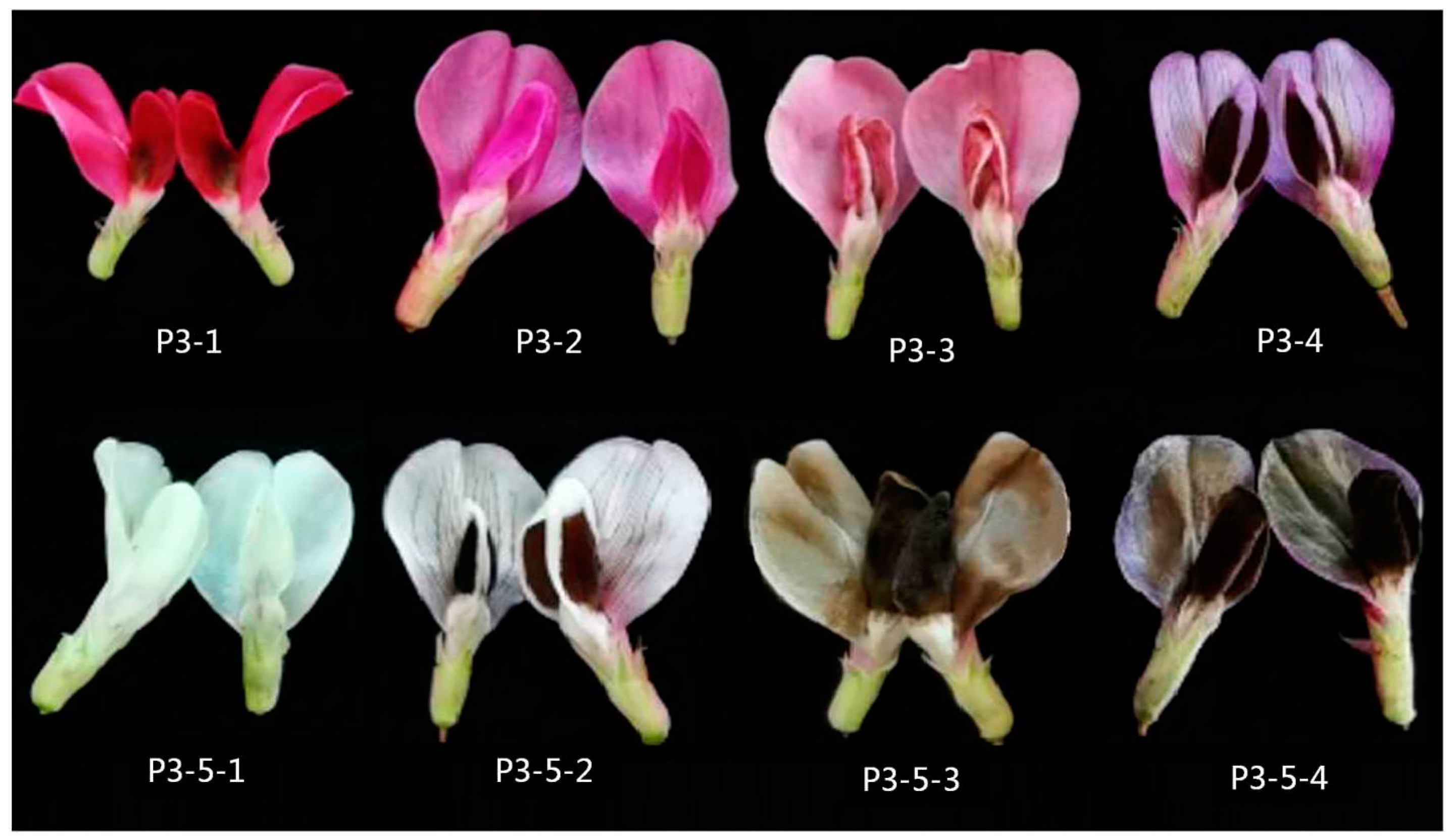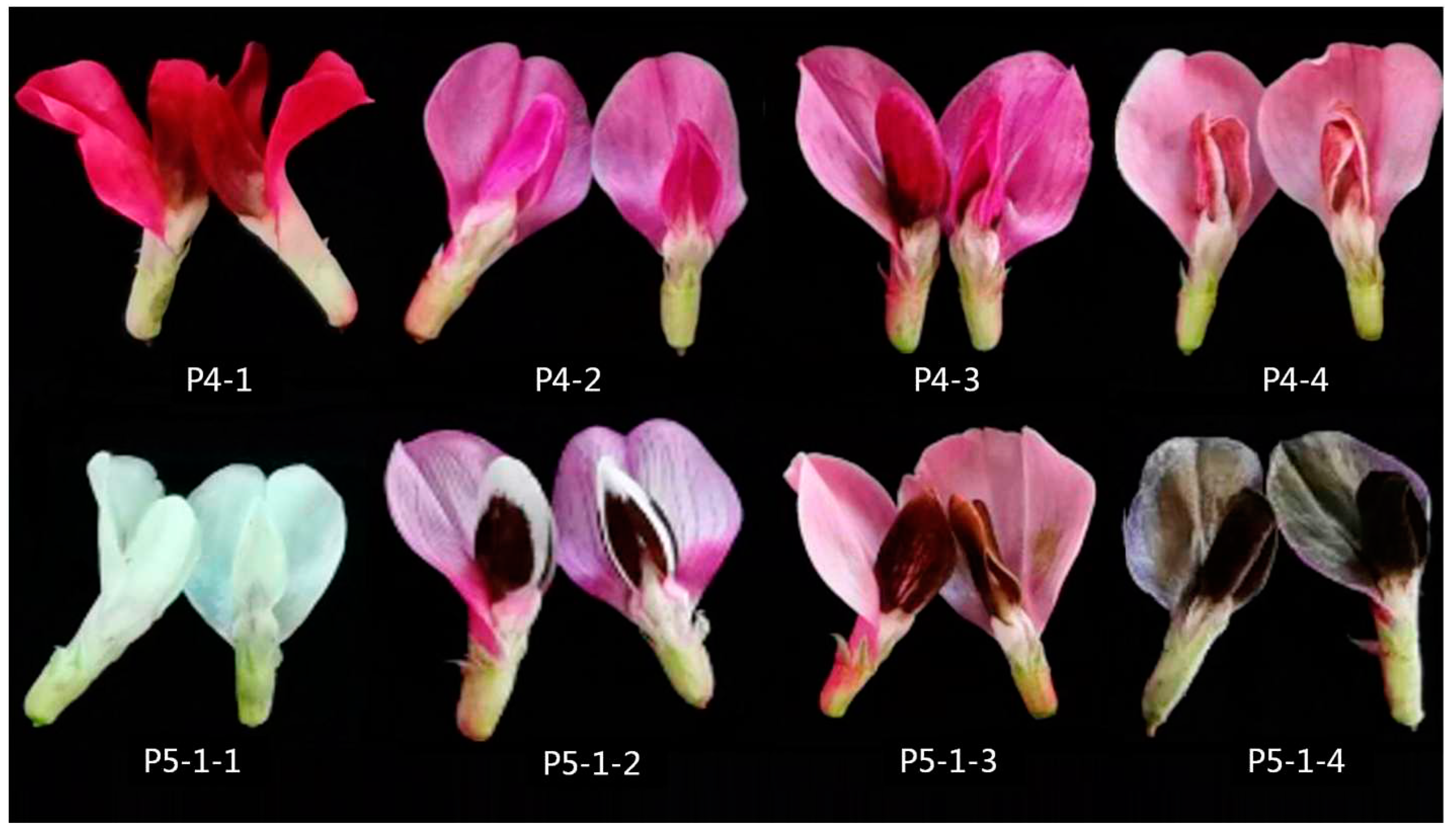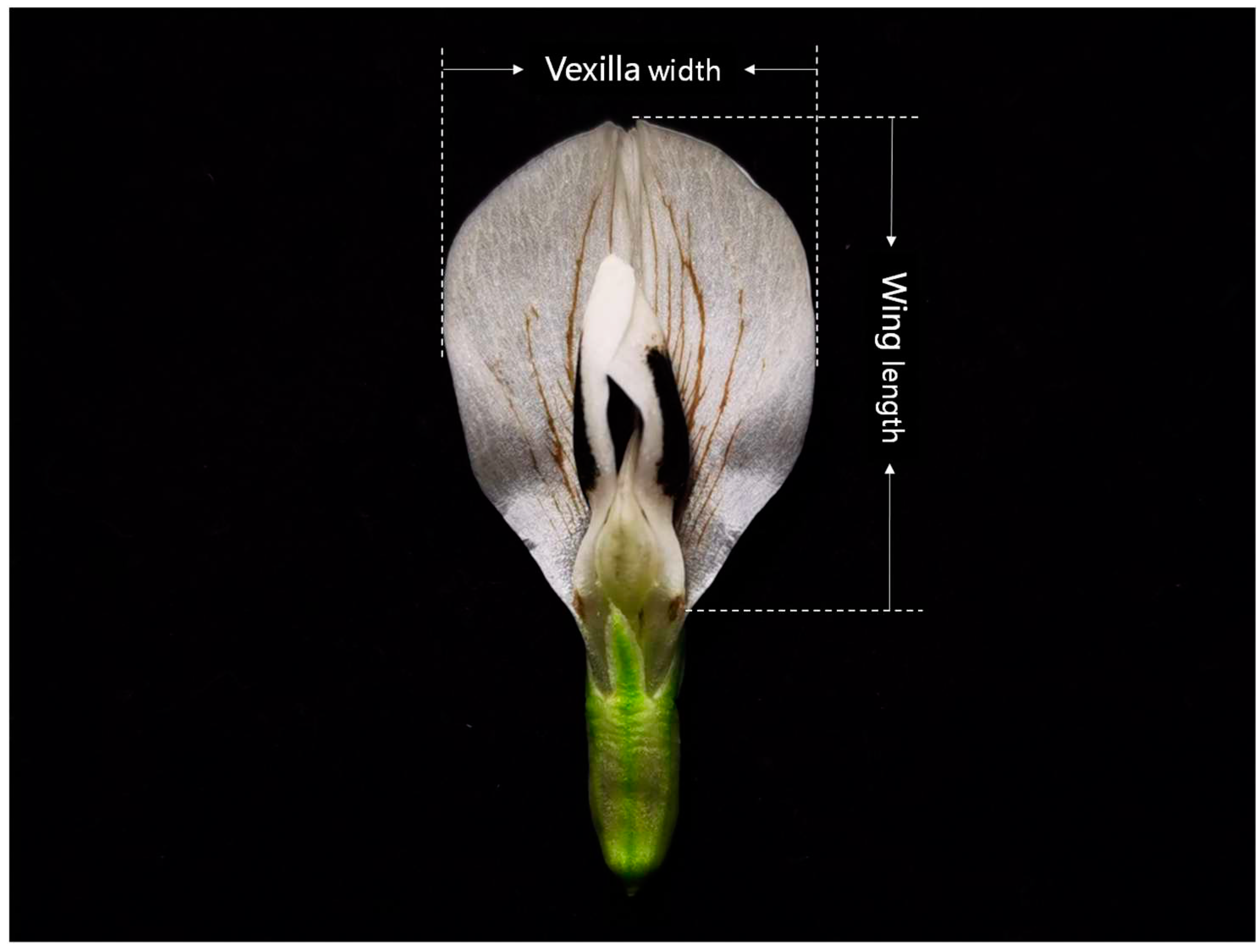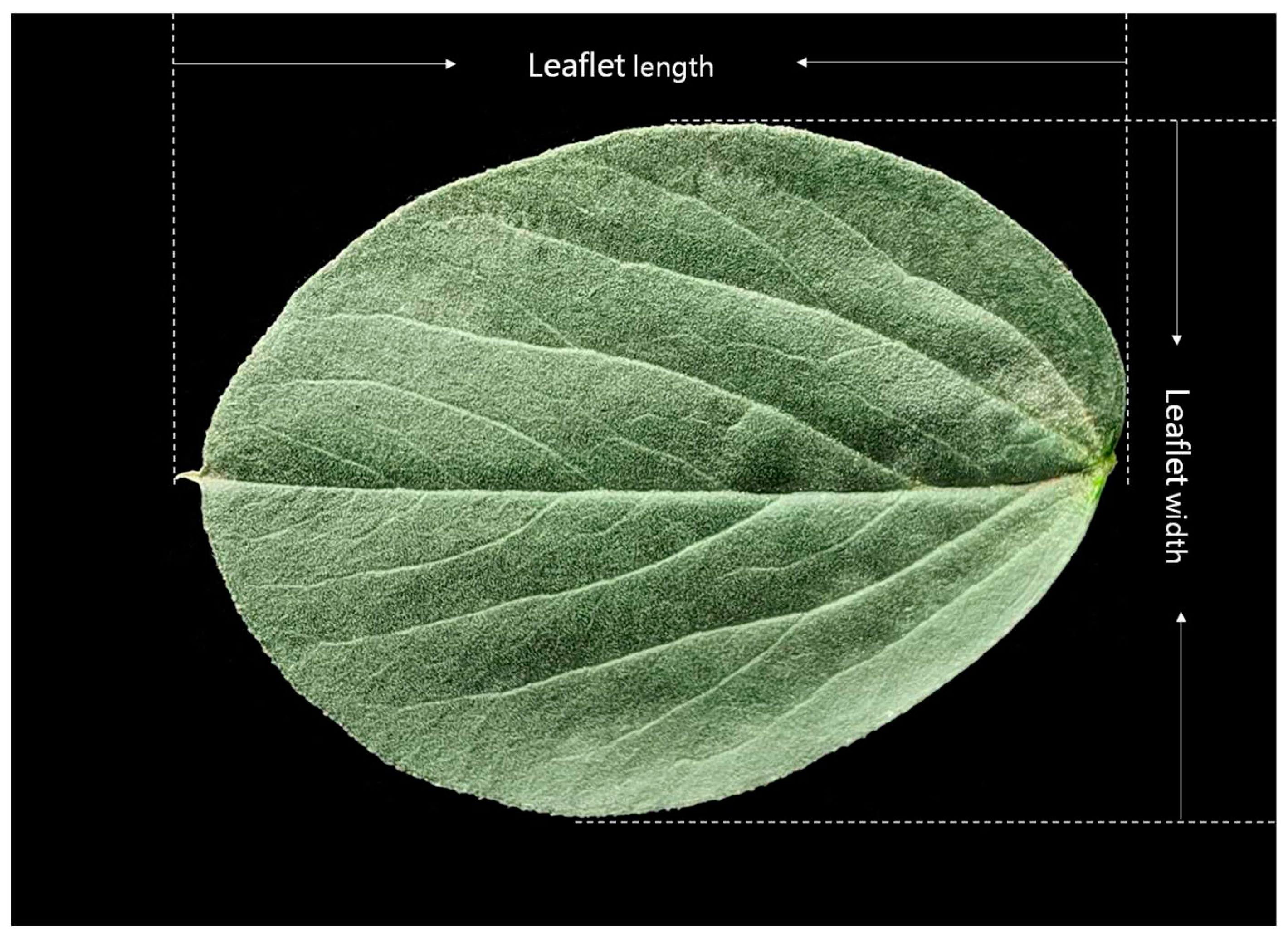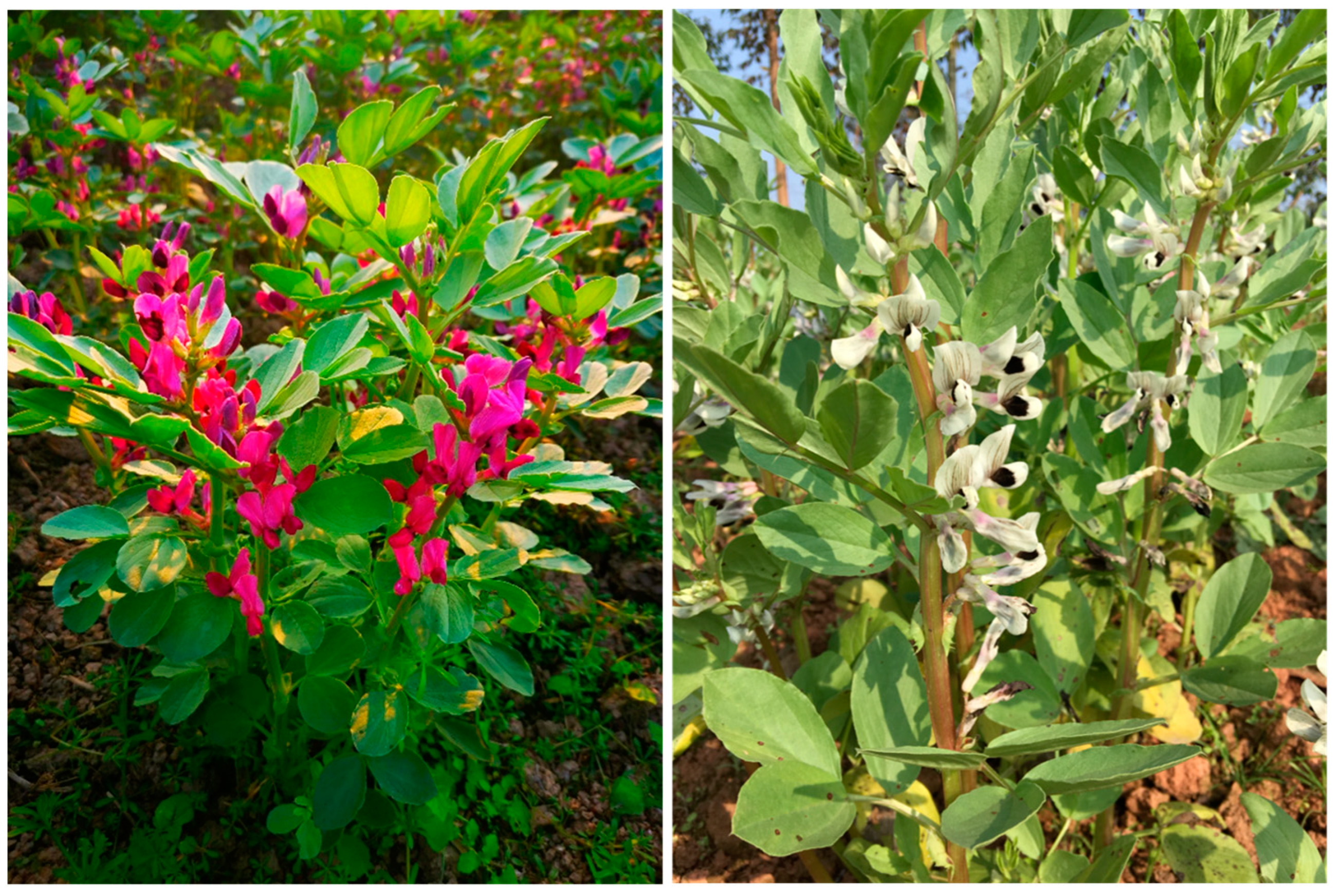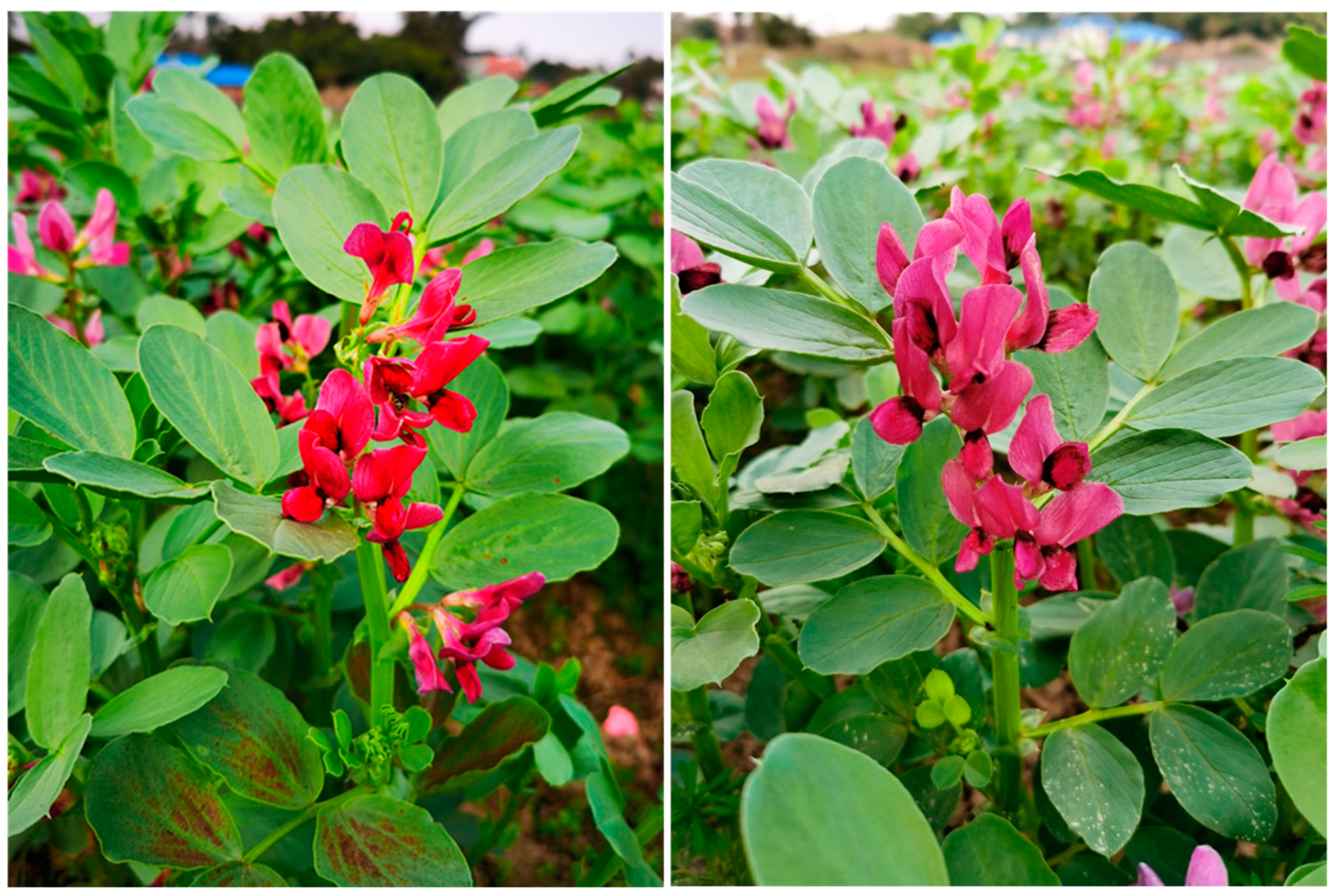1. Introduction
At present, the cultivation area of faba beans (
Vicia faba L.) in China is about 13 million mus, with an annual output of about 1.8 million tons, of which approximately 10 million mus are used to produce fresh food products with an output of about 6 million tons [
1] . Traditionally, faba beans have been classified into four types (food, vegetable, forage, and green manure) according to their functions [
2]. Faba beans bloom in large quantities and are fragrant [
3]. The flowers of faba beans are usually purple, white, or white with stripes, though rare flower colors such as red, pink, brown, and black also exist [
4], which have potential ornamental value. However, few researchers have studied the ornamental function of faba beans [
5] primarily because faba bean germplasms with rare flower colors are a scarce resource, and few breeders and breeding institutions in China have preserved such germplasms to develop breeding programs. Furthermore, the known faba bean germplasms with rare flower colors have low productivity, low stress resistance, and poor adaptability, and breeders have thus rarely used these germplasms in their breeding programs even when they have been available. Interestingly, the conventional faba bean varieties cultivated across the world all have infinite inflorescences whereby the flowers are hidden under the leaves, and so the overall ornamental value is unsatisfactory even if the flowers are charming. In addition, the natural outcrossing rate of faba beans exceeds 30% [
6,
7], further adding to the difficulty in improving faba bean varieties [
8]. For these reasons, breeders have rarely focused their efforts on breeding faba bean for ornamental purposes. The availability of faba bean germplasms with finite inflorescences is crucial to the breeding of ornamental faba bean varieties. A germplasm with a finite inflorescence was originally a mutant obtained by the Swedish scientist from the local variety ‘Primus’ following γ-ray treatment [
9]. Breeders believe that this type of faba bean has various advantages such as a short stalk, high harvest index, and concentrated pod setting, which are conducive to mechanized harvesting [
10]. In addition, we observed that in faba bean with finite inflorescences, most of the flowers were on top of the plants and were largely visible. If rare flower color genes can be expressed in faba beans with finite inflorescences, it could be possible to breed new varieties with high yield and ornamental value. The utilization of dual-purpose varieties may have landscaping value and promote the transformation of traditional faba bean cultivation into a multifunctional industry [
11].
We introduced the finite inflorescence of the faba bean germplasm ‘9913-2-1-2′ to the pink flower germplasm ‘6834-5-6′ from Qinghai University and the red flower germplasm ‘Crimson’ from Monks Farm in Colchester, Essex, England. In March 2010, in the Yongchuan District of Chongqing City, 9913-2-1-2 was used as the female parent and crossed with Crimson and 6834-5-6, and the F1 hybrid was obtained. In July 2010, in Xining City, Qinghai Province, the high-yield and chocolate spot disease-resistant faba bean germplasm ‘Su 03021′ and the ‘Yundou 147′ mutant were used as the female parents to cross with those F
1 plants. After 10 years of selection across multiple generations in Chongqing (sown in autumn) and Aba, Sichuan (sown in spring), a total of 37 lines were cultivated across 674 rows of plants. A total of 1782 individual plants were selected that possessed ornamental value and that were able to complete normal growth and developmental cycles in the high altitude and cold areas in Sichuan and warm winter areas in Chongqing. However, selection was made difficult due to the large number of offspring generated. Determining a method for effectively evaluating the phenotypes of faba beans for dual purpose was thus necessary. The Analytic Hierarchy Process (AHP) is a systematic and hierarchical analysis method for studying multi-factor issues [
12]. It combines quantitative and qualitative means to objectively and effectively reflect the effects of various factors and is widely used in the evaluation of the ornamental function of plants [
13,
14].
In this study, 37 new dual-purpose lines and two traditional varieties were used in the analysis. Fourteen ornamental phenotypes relating to inflorescence type, chocolate spot disease resistance, vexillum color, wing petal color, vexillum size, number of floral nodes, number of flowers at the top of the plants, length of the flower branches, number of branches on a stem, number of branches on the stem base, leaflet size, number of leaflets, plant height, and crown diameter, and three food-related phenotypes, including the number of pods per plant, number of seeds per pod, and 100-seed weight, were used to construct a comprehensive evaluation system to provide a scientific basis for the selection and breeding of new dual-purpose varieties.
2. Materials and Methods
2.1. Plant materials
Thirty-seven new faba bean breeding lines (GS1–GS37) with ornamental value were jointly bred by the Chongqing Academy of Agricultural Sciences and Qinghai University and used in this study. The traditional varieties ‘Cheng hu 10′ (CK1) and ‘Yu can 1′ (CK2) were used as controls.
2.2. Experimental design
The experiment adopted a random block design with three repetitions. The area of each plot was 10 m2. At the end of October 2020, seeds were sown in rows with 50 cm spacing between rows and 10 cm spacing between plants in a row. The ornamental phenotypes were investigated in the field at the full bloom stage. At the ripening stage, 10 plants from each plot were randomly selected for indoor determination of the food-related phenotypes.
2.3. Selection of phenotypes
The descriptions, specifications, and data standards for faba bean germplasm resources [
15] and the observation standards for ornamental plants [
16,
17] were used as references. After market investigation and consultation with experts, 17 phenotypes were ultimately selected for evaluating the breeding lines and varieties, which included inflorescence type, chocolate spot disease resistance, vexillum color, wing petal color, vexillum size, number of floral nodes, number of flowers at the top of plants, length of the floral branch, number of branches on the stem, number of branches on the stem base, leaflet size, number of leaflets, plant height, crown diameter, number of pods per plant, number of seeds per pod, and 100-grain weight.
2.4. Observation standards and methods
Inflorescence type: the flowering habit of the plants was investigated at the full bloom stage. Finite type was recorded as P1-1, and infinite type was recorded as P1-2 (
Figure 1).
Resistance to chocolate spot disease: the resistance of the plants was investigated at the full bloom stage, and the resistance levels were recorded as high resistance (HR), resistance (R), medium resistance (MR), susceptibility (S), and high susceptibility (HS).
Vexillum color: at the full bloom stage, newly opened flowers were observed, and the vexillum colors were recorded as red (P3-1), pink (P3-2), light pink (P3-3), purple (P3-4), and others (P3-5), including white (P3-5-1), white with stripes (P3-5-2), brown (P3-5-3), and black (P3-5-4) (
Figure 2).
Wing petal color: at the full bloom stage, newly opened flowers were observed, and the wing petal colors were recorded as red (P4-1), pink (P4-2), pink-brown (P4-3), light pink (P4-4), and others (P4-5), including white (P4-5-1), spots (P4-5-2), brown (P4-5-3), and black (P4-5-4) (
Figure 3).
Vexillum size: at the full bloom stage, the product (cm
2) of the length and width of the vexilla of the opening flowers was measured and calculated (
Figure 4).
Number of floral nodes: at the full bloom stage, the number of floral nodes with opening flowers on the highest stems or branches was counted.
Number of flowers at the top of plants: at the full bloom stage, the number of flowers between the top of the highest stems or branches and the leaf at the highest node was counted.
Length of the floral branches: at the full bloom stage, the length (cm) from top to the lowest floral node of the highest stems or branches was measured.
Number of branches on the stems: at the full bloom stage, the number of branches on the highest stems or branches was counted.
Number of branches at the stem base: at the full bloom stage, the number of branches at the stem base was counted.
Leaflet size: at the full bloom stage, the product (cm
2) of the length and width of the leaflet of the compound leaf at the first node from the top of the highest stems or branches was measured and calculated (
Figure 5).
Number of leaflets: at the full bloom stage, the number of leaflets on the first node at the top of the highest stems or branches was counted.
Plant height: at the full bloom stage, the length (cm) from the cotyledon node to the growth point at the top of the highest stems or branches of the plants was measured.
Crown diameter: at the full bloom stage, the diameter (cm) of the canopy of the plants was measured.
Number of pods per plant: at the ripening stage, the number of pods per plant was counted.
Number of seeds per pod: at the ripening stage, the number of mature seeds per pod was counted.
The 100-seed weight: the weight (g) of 100 mature and dry seeds was determined.
2.5. Statistics and evaluation
Based on the previous comprehensive evaluation system constructed for ornamental plants [
18,
19] and the opinion of experts, the ornamental and food-related phenotypes of faba beans were classified into four constrained layers, including overall sensory evaluation (C1), floral phenotype (C2), floral branch phenotype (C3), and food phenotype (C4) (
Table 1). According to the relationship between the evaluation factors, a comprehensive evaluation hierarchy structure for faba bean lines was constructed (
Table 1), including the target layer (T), constraint layer (C), and standard layer (P). SPSSAU software was used in organizing the phenotypic data, computing statistics, calculating the weight value of each evaluation factor according to the method reported by Deng et al. [
20], constructing a comprehensive evaluation system for dual-purpose faba bean lines by means of the Analytic Hierarchy Process, and ranking the lines.
According to the degree of contribution of each evaluation factor to the performance of dual-purpose faba bean lines, the 1–9 ratio scale[
21] was used to compare the importance of any two evaluation indexes, and T-C and C-P matrices were constructed (
Table 2). The consistency test showed that the CR values of the random consistency ratio were all less than 0.1, indicating that the constructed judgment matrix met the mathematical theoretical requirements, the relationship between the evaluation factors was reasonable, and the consistency was satisfactory.
3. Results
3.1. Scoring standards
Based on the phenotypic data collected during the period between 2009 and 2021 from various faba bean genetic populations created by the Chongqing Academy of Agricultural Sciences and Qinghai University, the observed phenotypic data in our study, and the opinions of experts, we set up scoring standards (
Table 3) for evaluating the performance of dual-purpose varieties, which was used as the basis for converting the phenotypic data of each line (
Table 4) (
Table 5).
3.2. Weight of the evaluation factors
According to the judgment matrix and consistency test (
Table 2), the final weight of each factor (Pi) to the total target layer (T) was calculated (
Table 6). The result showed that the type of inflorescence (the weight was 16.41%) had the greatest effect on the performance of the dual-purpose faba beans, followed by chocolate spot disease resistance (12.79%), vexilla color (11.63%), wing petal color (9.08%), number of flowers at the top of the plants (6.49%), vexilla size (6.45%), length of the floral branch (5.37%), plant height (4.74%), crown diameter (1.19%), number of pods per plant (3.65%), number of seeds per pod (4.16%), and 100-seed weight (4.70%), of which inflorescence type, chocolate spot disease resistance, vexilla color, and wing petal color accounted for 49.91% of the total weight value, indicating that these four phenotypes were crucial for the selection of dual-purpose faba beans.
3.3. Comprehensive evaluation of dual-purpose faba bean lines
The product of each phenotypic score of each line (
Table 5) and their weight to the target layer (
Table 6) were added together to obtain the comprehensive score of each line (
Table 7). Breeding lines with scores <4, 4–4.999, 5–5.999, 6–6.999, and ≥7 were ranked as 1, 3, 5, 7, and 9 grades, respectively. None of the lines reached grade 9. Two lines were excellent (grade 7), accounting for 5.13% of the evaluated materials, and had finite inflorescences, high resistance to chocolate spot disease, and dual functions as ornaments and food, and were expected to become new varieties. GS5, one of the two lines scored as grade 7, obtained the highest score and showed very high ornamental performance (
Figure 6) compared with the traditional varieties. It attracted most of the attention of the visitors. Fourteen lines were good (grade 5), accounting for 35.90% of the materials. They had finite inflorescences, and in terms of chocolate spot disease resistance, flower phenotypes, floral branch phenotypes, and food related phenotypes of the lines, they each had at least one phenotype with a low score. Seventeen lines were of medium grade (grade 3), accounting for 43.59% of the materials. Among the overall sensory evaluation, floral phenotypes, floral branch phenotypes, and food-related phenotypes of the lines, at least two phenotypes showed low scores. Four lines were poor (grade 1), accounting for 10.26% of the evaluated materials. They had infinite inflorescences, and at least two phenotypic traits among chocolate spot disease resistance, floral phenotype, floral branch phenotype, and food-related phenotypes were scored low. Both of the traditional faba bean varieties ‘Cheng hu 10′ (CK1) and ‘Yu can 1′ (CK2) were ranked grade 1, which confirmed that the traditional varieties had almost no ornamental function.
3.4. Breeding practice
On November 25, 2021, GS5 passed the identification of crop Identification Committee of Chongqing Seed Industry Association and was renamed “Doumei 1 hao” with the identification number of “202111”. The field test results showed that this variety is both ornamental and seed value. The growth stages was about 180d, the plant height was 74.5cm, and each plant had 4.3 branches. The flower color is pink, bright, definite inflorescence, the flowering period is about 40d, has high ornamental value; the middle and upper part bear pods, 11.4 pods per plant, the number of pods per plant is 2.2, the 100-grain weight of fresh grains is 130.2g. No obvious disease was found in the field. According to the yield measurement in the field. the cultivation density was 13492 plants /666.7 m2, and the fresh grain yield was 410.3. Kg /666.7m2, which was 3.9% higher than the control “chenghu 18”.
4. Discussion
As the technologies in various traditional fields mature, revolutionary technological innovations often appear at cross-field junctions [
22]. Cross-disciplinary research has a great effect on scientific and technological innovation [
23]. Developing faba bean lines with both ornamental and landscape functions represents a cross-field innovation in faba bean breeding. Over a period of 10 years, we achieved a breakthrough in developing a batch of new faba bean lines and genetic materials with ornamental value. Effectively selecting from a large number of target materials is a challenge faced by all breeders. The construction of a comprehensive evaluation system is thus necessary for the selection and breeding of new faba bean varieties for both ornamental and food applications.
In this study, the Analytic Hierarchy Process was used to analyze 17 phenotypes of dual-purpose faba bean breeding lines to clarify the key phenotypes for selection, of which inflorescence type obtained the greatest weight, followed by chocolate spot resistance, vexilla color, and wing petal color. The 37 faba bean lines with dual functions and two traditional varieties were classified into five grades, and two lines with excellent phenotypes and dual functions were selected. The results showed that the comprehensive evaluation system constructed in this study could effectively select new faba bean varieties for dual purposes, thus providing a scientific basis for assisting breeders in making selection decisions.
When comparing the importance of the phenotypes, the resistance to chocolate spot disease was of high priority in this study, as the occurrence and prevalence of chocolate spot disease severely restricts the development of the faba bean industry in southwestern China. Once faba bean plants are moderately infected with chocolate spot disease, their leaves appear burnt and the growth and development of the plants are severely restricted, leading to significant damage to productivity and ornamental performance. Therefore, improving the resistance to chocolate spot disease has always been one of the most important goals in faba bean breeding in southwestern China [
24]. In other areas, the importance of disease and insect resistance in the breeding of dual-purpose faba bean varieties can be adjusted to appropriate levels according to the local conditions. In this study, the calculated weighting of chocolate spot disease resistance was 12.79%, which ranked second in importance. This ensured that the two excellent faba bean lines selected under the conditions of this study possessed a suitable level of resistance to chocolate spot disease.
Although none of the lines in this study reached grade 9, this does not mean there is no superior faba bean germplasm. In the faba bean breeding populations we developed for selecting dual-purposes varieties, a batch of individual plants and rows with red vexilla and wing petals and good food-related performance was found and preserved. For example, GS2020-23-31 was evaluated using the same system and showed a comprehensive score of 7.033, thus reaching a superior grade. Its ornamental performance was better than that of the pink flowers (
Figure 7). However, it still needs purification and propagation, and as it had not yet reached the required standard as a new line, it was not included in this study. Nevertheless, its position in the evaluation system has been noted, and this individual plant may be used as a benchmark for scientists wishing to breed dual-purpose faba bean varieties.
Esthetic sense is highly variable [
25]. We tended to give a high score to faba beans with bright colors, such as red and pink, though the other colors were not necessarily unattractive. This is one of the shortcomings of the Analytic Hierarchy Process; that is, the selection of qualitative phenotypes cannot satisfy everyone [
26]. Therefore, it is recommended that breeders retain or select germplasms with excellent food traits and pure white, brown, and black flowers to meet niche market and gardening requirements.
Author Contributions
JZ was responsible for the study design. JC and MY performed to the tests and investigations referred to in the manuscript. YL, WL, and CT analyzed the data. All the authors contributed to the writing of the manuscript, and all authors read and approved the final manuscript.
Funding
This study was supported by Key Laboratory of Evaluation and Utilization for Special Crops Germplasm Resource in the Southwest Mountains,Ministry of Agriculture and Rural Affairs (Co-construction by the Ministry and Province), the China Agriculture Research System of MOF and MARA- Food Legumes(CARS-08), the Jiangjin Experimental Station of National Germplasm Resources (NEAS 025GR05), the Chongqing Science and Technology Bureau (cstc2021jscx-gksbx0011), and the Research and demonstration on integrated innovation of new peanut and bean varieties with Sichuan-Chongqing characteristics (2020YFQ0044).
Data Availability Statement
All datasets generated for this study are included in the article/supplementary material.
Acknowledgments
We would like to thank the Chongqing Science and Technology Bureau, the National Industrial Technology System and Yong chuan Science and Technology Bureau for the financial assistance in this research. We also thank LetPub (
www.letpub.com) for its linguistic assistance during the preparation of this manuscript.
Conflicts of Interest
The authors declare that the research was conducted in the absence of any commercial or financial relationships that could be construed as a potential conflict of interest.
References
- Liu, Y. J., H. Y. Zhang, X. L. Guo, and X. L. Zhou. 2020. Current status and future development of broad bean industry under the government policy “Giving priority to ecological environment protection, promoting high quality development, and pursuing high quality life”. Qinghai Sci. and Tec. 27: 18-21. Available online: https://kns.cnki.net/kcms/detail/detail.aspx?FileName=QKKJ202006008&DbName=CJFQ2020.
- Hauggaard,N., H. Peoples, and M. B. Jensen. 2010. Faba bean in cropping systems. Field Crops Res.115:203-216. [CrossRef]
- Griffiths, D. W., G. W. Robertson, and T. Shepherd, 1999. Epicuticular waxes and volatiles from faba bean (Vicia faba) flowers. Phytochemistry. 52:607-612. [CrossRef]
- Cabrera, A. 1989.Genetics of tannin content and its relationship with flower and testa colours in Vicia faba. J. Agr. Sc.
- Hughes, J., H. Khazaei , and A. Vandenberg. 2020. The Study of Genetics of Flower Color in Faba Bean Reveals Generous Diversity to Be Used in the Horticulture Industry. H ASHS. 55:1-5. [CrossRef]
- Hu, J., E. J. Landry , J. E. Mwengi, and C. J. Coyne. 2011. Natural outcrossing rate of faba bean under pullman field conditions and its implication to germplasm management and enhancement. Power Engineering.
- Suso, M. J., S. Nadal , and M. T. Moreno. 2003. Relationship between outcrossing and floral characteristics in faba bean: implications for the design of synthetic varieties. J.of Gen. & Bre., 41, 78-124(47).
- Yu, H.T., L.P. Wang, F. Yang, M.Y. Lv, X.X. Zong,Y.Tang, C.Q.Hu, X.Yang, Y.B. Wang, and Y.H.He. 2020.Identification and Utilization of Short Wing Petal Broad Bean (Vicia faba L.) Germplasm. J. of P. Gen.Res. 20:1334-1339+1348. [CrossRef]
- Holden, J., and D. A. Bond. 1960. Studies on the breeding system of the field bean, (vicia faba L.). Heredity, 44, 981-988. [CrossRef]
- Hou, W. W., Q.B.Yan , P. Li, and Y.J. Liu. 2014 . Study on inheritance of growth habit in broad bean . Acta Agr. Bor.-Occid. Sin.,2014,23:145-147. [CrossRef]
- Sayer, J., T. Sunderland, and J. Ghazoul. 2013. Ten principles for a landscape approach to reconciling agriculture, conservation, and other competing land uses. PNAS. 110:8349. [CrossRef]
- Saaty, T. L. 1994. How to Make a Decision: The Analytic Hierarchy Process. EJOR. [CrossRef]
- Bravo-Bello, J. C., T. Martínez-Trinidad, E.Romero-Sanchez, J. R. Valdez-Lazalde, and H. Benavides-Meza. 2020. The analytic hierarchy process for selection of suitable trees for mexico city. Forest - Biogeosciences and Forestry, 13, 541-547. [CrossRef]
- Rong, L., J. Lei, and W. Chong. 2011. Collection and evaluation of the genus lilium resources in northeast china. Genet. Resour. Crop Evol. 58, 115-123. [CrossRef]
- Zong, X.X. 2006. Description and Data Standard for Faba bean (Vicia faba L.).Beijing: China Agriculture.
- Xing, G., L. Qu , Y. Zhang , L. Xue , J.Su , and J. Lei. 2017. Collection and evaluation of wild tulip (tulipa spp.) resources in china. Genet. Resour. Crop Evol. 64, 1-12. [CrossRef]
- Dilta, B. S., Y. D. Sharma, and V. K. Verma. 2005. Evaluation of Chrysanthemum Cultivars Under sub-tropical Region of Himachal Pradesh.
- Barik, D., and C. R. Mohanty. 2015. Evaluation of asiatic hybrid lily varieties under bhubaneswar condition. The Asian Journal of Horticulture. 10: 194-200. [CrossRef]
- Gaikwad, A.M. , and S.S. DumbrePatil. 1996. Evaluation of Chrysanthemum Varieties Under Open and Polyhouse Conditions.
- Deng, X., J.M.Li, H.J.Zeng , J.Y. Chen, and J.F. Zhao. 2012. Research on computation methods of ahp wight vector and its applications. Mathematics in Practice and Theory. 42(07):93-100. [CrossRef]
- Zhang, C.G., and Z.N. Wu. 2020.Improvement and analysis of scale of AHP. Journal of Zhengzhou University of Technology. 21(2). [CrossRef]
- Lü, H.B., H. B. Li, Y. Y. Wei, and D. F. Liu. 2016. Application of comprehensive integration thinking in cross-field innovation management. Aerospace Industry Management, 2016, 000 (010): 22-24. [CrossRef]
- Wang, L.R. 2003. Role of cross-disciplinary research in promoting scientific and technological innovation. Science &Technology Progress and Policy, 2003(S1): 2-3.
- Du, C.Z,, J.C. Long, W.Z. Gong, Z.D. Zhu, X.X. Zong , and J.J.Zhang. 2019. Analysis of major genes plus polygenes mixed inheritance for resistance to chocolate spot on faba bean . Plant Protection. 45(06):131-137. [CrossRef]
- Li, J.H., and Y.J. Ding. 2008. Design Aesthetics - Design must have connotation . Art and Design: Theory Edition. 3:20-22. [CrossRef]
- Ma, N. L., and Z. J. Zhao. 2006. The analyses of calculating the proportion based on analytic hierarchy process and the improved AHP. WCST E, 11:732-733. [CrossRef]
|
Disclaimer/Publisher’s Note: The statements, opinions and data contained in all publications are solely those of the individual author(s) and contributor(s) and not of MDPI and/or the editor(s). MDPI and/or the editor(s) disclaim responsibility for any injury to people or property resulting from any ideas, methods, instructions or products referred to in the content. |
© 2023 by the authors. Licensee MDPI, Basel, Switzerland. This article is an open access article distributed under the terms and conditions of the Creative Commons Attribution (CC BY) license (http://creativecommons.org/licenses/by/4.0/).

